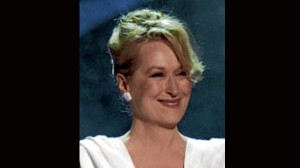LOS ANGELES—Meryl Streep’s Best Actress nomination for her terrific portrayal of Maggie Thatcher through several decades in “The Iron Lady” is her 14th in this category. The nod increases Meryl’s lead as the most nominated thespian in Academy history, with 17 nominations overall.
As the Academy prepares for its eagerly anticipated show on Sunday (Monday morning, Manila time), it supplied the above trivia and more in the following:
Two separate writing teams, on the East and West coasts, have been collaborating with host Billy Crystal. Host writers help Billy with his material, while show writers are responsible for the presenters’ spiels.
When the first Academy Awards was held in 1929, the guest count was 270, and the guest ticket price was $5. The seating capacity of the Kodak Theatre (now referred to as the Hollywood & Highland Center, following Kodak’s bankruptcy proceedings), as reconfigured on Oscar night, is 3,300.
Embargo
In the first Academy Awards, the winners, believe it or not, were announced to the public three months in advance! Then, for the next 10 years, the winners’ list was given in advance to newspapers for publication at 11 p.m. on the night of the Academy Awards. In 1940, the LA Times broke the embargo and published the list of winners in its evening edition, ending the suspense for the Academy guests arriving for the event. That led to the Academy’s sealed-envelope system the following year, a practice that continues to this day.
Seven years after it debuted, the Academy Awards introduced the Best Supporting Actor and Actress categories.
There were only three instances in which the awards did not go on as scheduled—in 1938, floods delayed the show by a week; in 1968, the ceremony was held two days later than the original date, out of respect for Martin Luther King Jr. who was assassinated a few days earlier; in 1981, the assassination try on President Ronald Reagan forced the postponement of the ceremony by 24 hours.
Even the Academy concedes that the origins of the statuette’s name, Oscar, are not clear. It does offer the popular story that Academy librarian, Margaret Herrick, who went on to become an executive director, said that the statuette resembled her Uncle Oscar. The Academy staff reportedly began calling the statuette as Oscar from then on.
Oscar was the creation of two artists—MGM art director, Cedric Gibbons, who designed the statuette and sculptor George Stanley, who was commissioned to make the figure of a knight standing on a film reel, hands gripping a sword. The famous gold statuette is 13-1/2 inches tall, weighs eight and a half pounds, and has a diameter of five and a half inches.
Metal shortage
Oscar was originally a gold-plated solid bronze. For three years during the metal shortage in World War II, Oscar was made of painted plaster. After the war, the plaster figures given to the winners were replaced with gold-plated metal ones.
Sixty-three countries submitted entries in the Best Foreign Language Film.
The Oscar telecast is seen in more than 225 countries. Approximately 350 crew members work during the telecast. The longest telecast was in 2002—with a running time of four hours and 23 minutes!
After the show, usually the first stop of the Oscar winners, nominees and telecast participants is the Governors Ball. There are about 1,500 guests. A menu created by Wolfgang Puck features chocolate buffet, which includes chocolate paninis, Earl Grey Tea Truffles and Raspberry Rose Eclairs. Twenty-five pounds of Edible Gold Dust will be used.
The ball has 12,000 glasses for beverages and 1,000 bottles of Moet & Chandon Champagne.
E-mail rvnepales_5585@yahoo.com. Follow https://twitter.com/nepalesruben.
